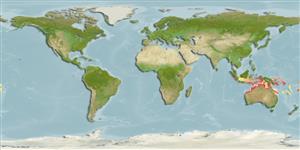>
Eupercaria/misc (Various families in series Eupercaria) >
Lethrinidae (Emperors or scavengers) > Lethrininae
Etymology: Lethrinus: Greek, lethrinia, a fish pertaining to genus Pagellus.
More on authors: Alleyne & Macleay.
Environment: milieu / climate zone / depth range / distribution range
экология
морской; солоноватоводный ассоциированный с рифами; немигрирующий; пределы глубины 5 - 35 m (Ref. 90102). Tropical; 3°S - 23°S
Western Pacific: southern Indonesia, northern Australia, Papua New Guinea and the Solomon Islands. There has been considerable confusion in the use of names for this species. In recent literature it is referred to as Lethrinus fraenatus (a junior synonym of Lethrinus nebulosus) or Lethrinus fletus (a junior synonym of Lethrinus laticaudis).
Size / Вес / Возраст
Maturity: Lm ? range ? - ? cm
Max length : 56.0 cm TL самец/пол неопределен; (Ref. 2295); common length : 35.0 cm TL самец/пол неопределен; (Ref. 2295)
колючие лучи спинного плавника (общее число) : 10; членистые (мягкие) лучи спинного плавника (общее число) : 9; колючие лучи анального плавника: 3; членистые (мягкие) лучи анального плавника: 8. Cheek without scales; the inner base of pectoral fins densely covered with scales. Body is tan, brown or yellow with scattered irregular blotches; head brown or yellow with blue dots on cheeks and short blue stripes radiating in front and behind the eye, sometimes a number of blue cross stripes between the eyes; fines pale or yellow, the vertical fins are mottled.
Juveniles found in seagrass beds and mangrove swamps. Adults found over coral reefs. Often in schools (Ref. 9710). Feeds mainly on crustaceans and fishes. Considered a good food fish. Marketed fresh (Ref. 9775).
Life cycle and mating behavior
половая зрелость | размножение | нерест | икра | Fecundity | личинки
Carpenter, K.E. and G.R. Allen, 1989. FAO Species Catalogue. Vol. 9. Emperor fishes and large-eye breams of the world (family Lethrinidae). An annotated and illustrated catalogue of lethrinid species known to date. FAO Fish. Synop. 125(9):118 p. Rome: FAO. (Ref. 2295)
Статус Красного Списка МСОП (Ref. 130435: Version 2024-2)
Угроза для людей
Harmless
Использование человеком
рыболовство: коммерческий; объект спортивного рыболовства: да
дополнительная информация
инструменты
Специальные отчеты
Скачать в формате XML
ресурсы в Интернет
Estimates based on models
Preferred temperature (Ref.
123201): 26.3 - 28.8, mean 27.7 °C (based on 242 cells).
Phylogenetic diversity index (Ref.
82804): PD
50 = 0.5000 [Uniqueness, from 0.5 = low to 2.0 = high].
Bayesian length-weight: a=0.01479 (0.00699 - 0.03129), b=2.98 (2.81 - 3.15), in cm total length, based on LWR estimates for this Genus-body shape (Ref.
93245).
Trophic level (Ref.
69278): 4.5 ±0.8 se; based on diet studies.
устойчивость к внешним воздействиям (Ref.
120179): средний (среднего размера), минимальное время удвоения популяции 1.4-4.4 года (Preliminary K or Fecundity.).
Fishing Vulnerability (Ref.
59153): Moderate vulnerability (42 of 100).
Nutrients (Ref.
124155): Calcium = 36.6 [23.6, 61.2] mg/100g; Iron = 0.797 [0.506, 1.323] mg/100g; Protein = 20.6 [18.0, 22.8] %; Omega3 = 0.139 [0.091, 0.215] g/100g; Selenium = 33.4 [18.0, 60.4] μg/100g; VitaminA = 54.5 [11.0, 309.5] μg/100g; Zinc = 1.93 [1.34, 2.67] mg/100g (wet weight);
